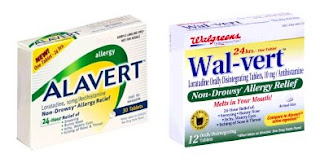Divided TTAB Panel Finds "ALAVERT" and "WAL-VERT" Confusingly Similar for Antihistamines
A divided Board panel sustained Wyeth's opposition to registration of the mark WAL-VERT for "antihistamines and allergy relief preparations," finding it likely to cause confusion with Opposer's registered mark ALAVERT for allergy relief and antihistamine preparations. Although Walgreen sells its WAL-VERT product only in its own stores, in packaging that bears the Walgreen house mark and displayed on store shelves next to the ALAVERT product, the panel majority was constrained to consider Walgreen's mark and goods as stated in its application, without any such real-life restrictions. Wyeth v. Walgreen Co., Opposition No. 91165912 (August 5, 2008) [not precedential]. [N.B. This decision was vacated by order of the Board on April 21, 2010 (here)].

ALAVERT and WAL-VERT are chemically identical (loratadine being the main ingredient). Walgreen acknowledged that the "VERT" suffix is derived from the ALAVERT mark. The panel majority concluded that Applicant selected the "VERT" element "because potential purchasers were familiar with opposer's ALAVERT mark and product due to the success of the ALAVERT product."
Walgreen argued that confusion is unlikely because it sells its WAL-VERT product only in its own stores, and uses its house mark and company name repeatedly on the packaging. But the Board pointed out that the opposed application contains no such limitations.
Walgreen contended that ALAVERT is a weak and descriptive mark because if "creates the impression that the product 'acts to avert allergies.'" The Board dismissed this contention "out of hand," since it constitutes an improper attack on the validity of a pleaded registration. Instead the panel found the mark to be a coined term that is at most suggestive, and is a "strong mark conceptually." It is also "commercially strong" in view of its "impressive" sales and related advertising and promotional efforts.
The Board agreed with Applicant that the goods are not purchased on "impulse," but rather with a certain degree of care, as with any medication. However, they are relatively inexpensive goods, sold to a large segment of the general public, including some who are less sophisticated.
As to the lack of actual confusion, the panel majority found that there may not have been a "true opportunity for confusion," since the Walgreen product is sold only in its own stores and side-by-side with the Wyeth product. The opposed application, however, contains no such restrictions on sales.
Turning to the marks, the majority noted that "AL" is used in other marks for allergy medications and is weaker than the VERT component, which appears to be "strong in the field." The two marks have "common suggestive meanings" regarding their role in averting allergies. Under typical marketplace conditions, the Board concluded, potential purchasers "are likely to believe that the owner of the ALAVERT mark is associated with the WAL-VERT product in some fashion."
Weighing the relevant duPont, the panel majority (Judges Walsh and Mermelstein) ruled that confusion is likely and it sustained the opposition.
In dissent, Judge Drost stated his view that, comparing the marks in their entireties, the dissimilarities in their sound, appearance, meaning, and commercial impression outweigh the similarities. Moreover, he would give great significance to the lack of actual confusion because there was a "significant opportunity for confusion."
TTABlog comment: In the real world, I don't think there is any appreciable likelihood of confusion between these two marks, given the way Walgreen packages its product and sells it only in its own stores. On the other hand, the TTAB does not deal with the real world but with an artificial world in which one looks only at the marks and goods as stated in the opposed application. If you want the real world, go to the courts. There, I think Walgreen would prevail.
Text Copyright John L. Welch 2008.




0 Comments:
Post a Comment
<< Home